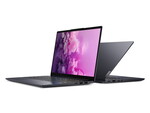Lenovo Yoga Slim 7i Pro
Specifications

Price comparison
Average of 4 scores (from 9 reviews)
Reviews for the Lenovo Yoga Slim 7i Pro
Source: Zdnet.com
 Archive.org version
Archive.org versionThe Lenovo Yoga Slim 7i Pro (a.k.a. Lenovo Slim 7i ) is a no-frills 14-inch laptop with a robust chassis and a great keyboard. The IPS screen's 2.8K resolution delivers clear images, text and video with up to 400 nits brightness. It's a shame the display doesn't rotate fully, and many will bemoan the lack of a touch screen option. But what really lets the Yoga Slim 7i Pro down is its battery life, which would not see me through a normal working day.
Single Review, online available, Medium, Date: 06/08/2022
Rating: Total score: 79%
Source: Unbox
 Archive.org version
Archive.org versionOur review of the Yoga Slim 7i Pro in the Philippines shows that Lenovo is elevating standards as far as premium mid-range notebooks are concerned. Sticking to the same design language of the previous-generation Yoga S740, Lenovo introduced substantial upgrades to the Yoga Slim 7i Pro that include a higher-resolution IPS panel with 90hz refresh rate, improved keyboard, and a more powerful MX450 discrete GPU.
Single Review, online available, Medium, Date: 08/23/2021
Source: Laptop Media
 Archive.org version
Archive.org versionSupport, online available, Short, Date: 05/19/2021
Foreign Reviews
Source: CNet France
 FR→EN Archive.org version
FR→EN Archive.org versionSingle Review, online available, Very Short, Date: 01/24/2022
Rating: Total score: 70%
Source: Log.com.tr
 TR→EN Archive.org version
TR→EN Archive.org versionSingle Review, online available, Very Long, Date: 01/16/2022
Rating: Total score: 91%
Source: Chip Online TR
 TR→EN Archive.org version
TR→EN Archive.org versionSingle Review, online available, Short, Date: 12/15/2021
Rating: Total score: 90%
Source: Zive
 CZ→EN Archive.org version
CZ→EN Archive.org versionPositive: Slim size; light weight; excellent display; metal case; premium design; great built quality.
Single Review, online available, Medium, Date: 05/04/2021
Source: Jagat Review
 ID→EN Archive.org version
ID→EN Archive.org versionPositive: Powerful processor; high gaming performance; excellent display; long battery life; nice cameras; great display; good connectivity.
Single Review, online available, Very Long, Date: 03/02/2021
Source: Pemmzchannel
 ID→EN Archive.org version
ID→EN Archive.org versionPositive: Slim size; light weight; elegant design.
Single Review, online available, Very Short, Date: 01/11/2021
Comment
NVIDIA GeForce MX450: Gimped GeForce GTX 1650 (Turing TU117) based entry level GPU with GDDR5 or GDDR6 graphics memory. Available in 4 different variants, where the LP = low power version with 12 Watt TGP is the slowest.
Modern games should be playable with these graphics cards at low settings and resolutions. Casual gamers may be happy with these cards.
» Further information can be found in our Comparison of Mobile Graphics Cards and the corresponding Benchmark List.
i7-1165G7: An upper mid-range, quad-core processor of Tiger Lake product family. The i7 is designed for use in ultra-light (yet actively cooled) laptops; it is manufactured on Intel's third-gen 10 nm process marketed as SuperFin. The CPU cores run at 2.8 GHz (base clock speed @ 28 W TDP) to 4.7 GHz (single-core Boost frequency). This i7 features the 96 EU Intel Iris Xe G7 iGPU; it was the second-fastest CPU of TGL-UP3 line-up when Intel initially launched the series in 2020.» Further information can be found in our Comparison of Mobile Processsors.



